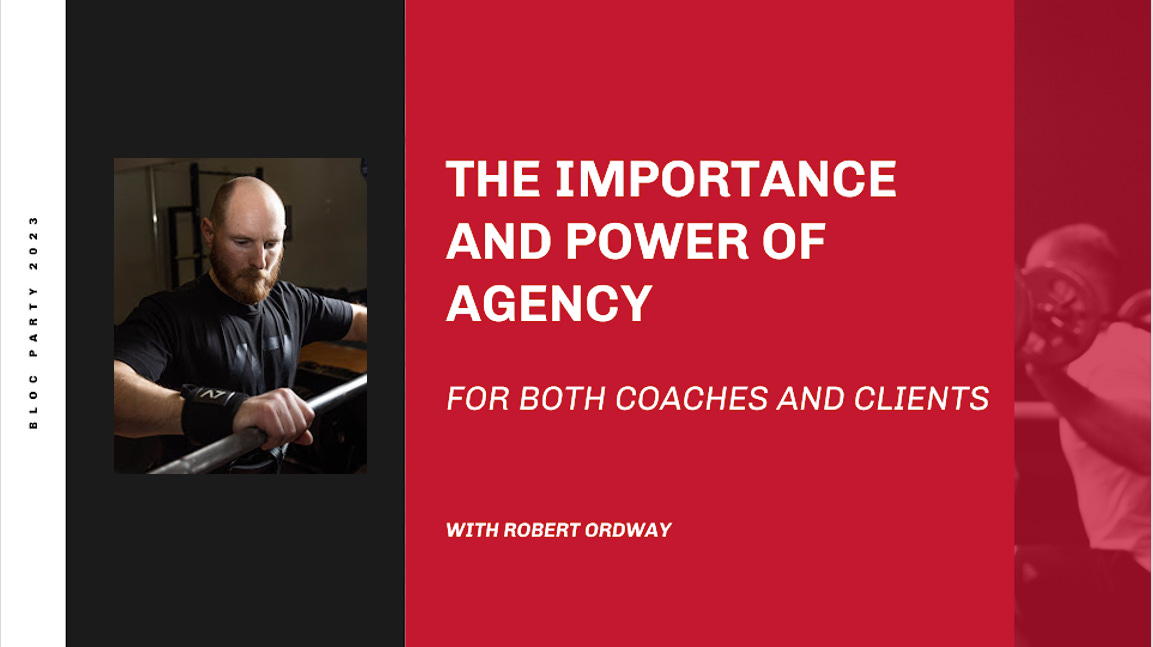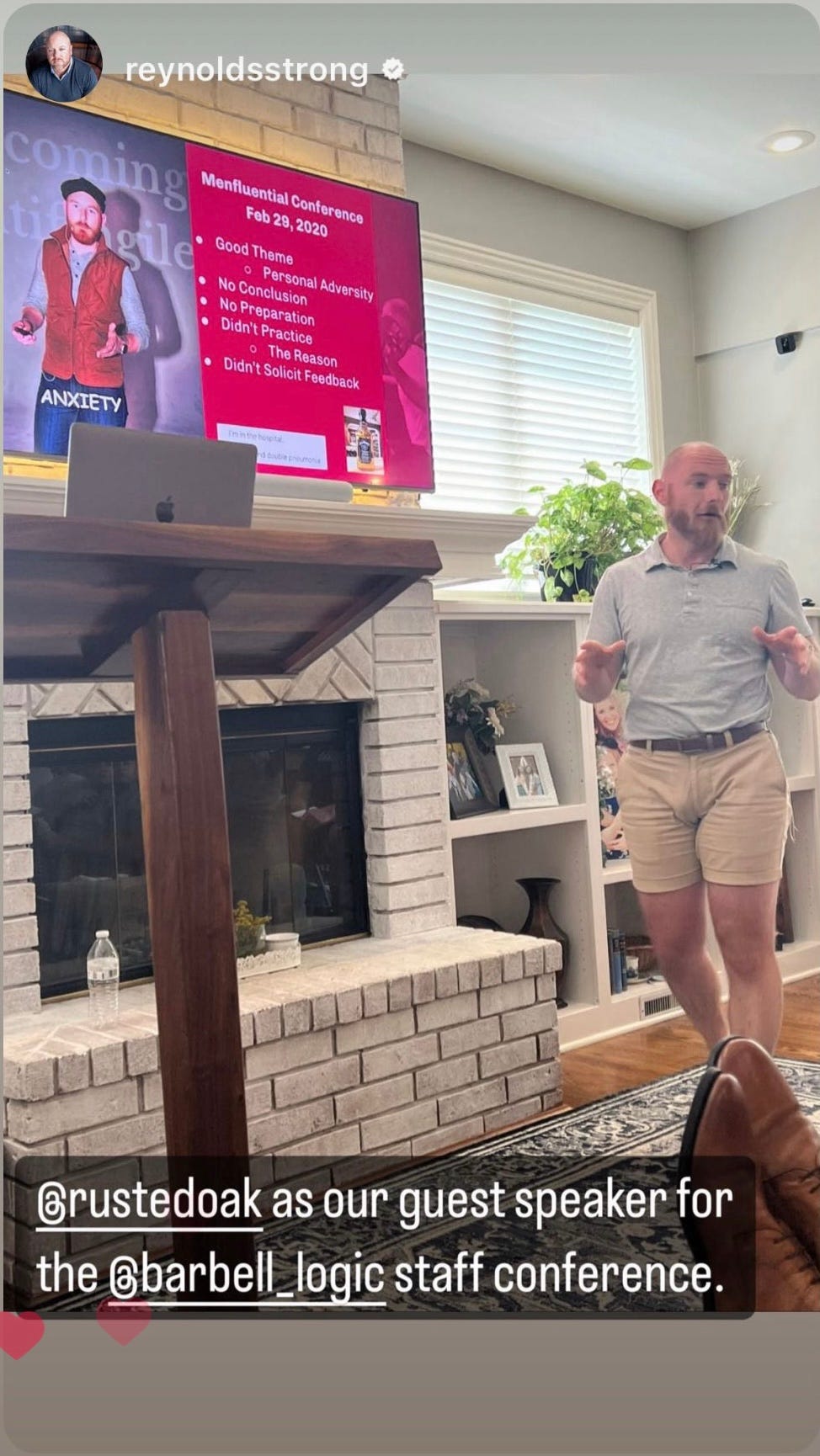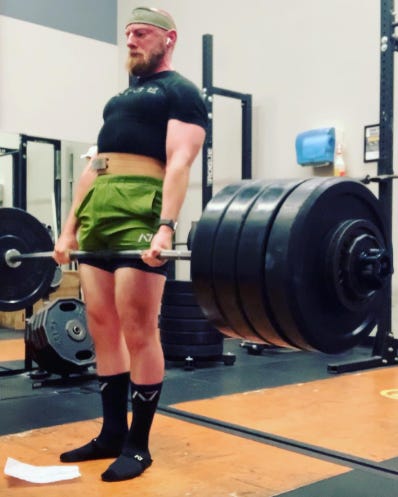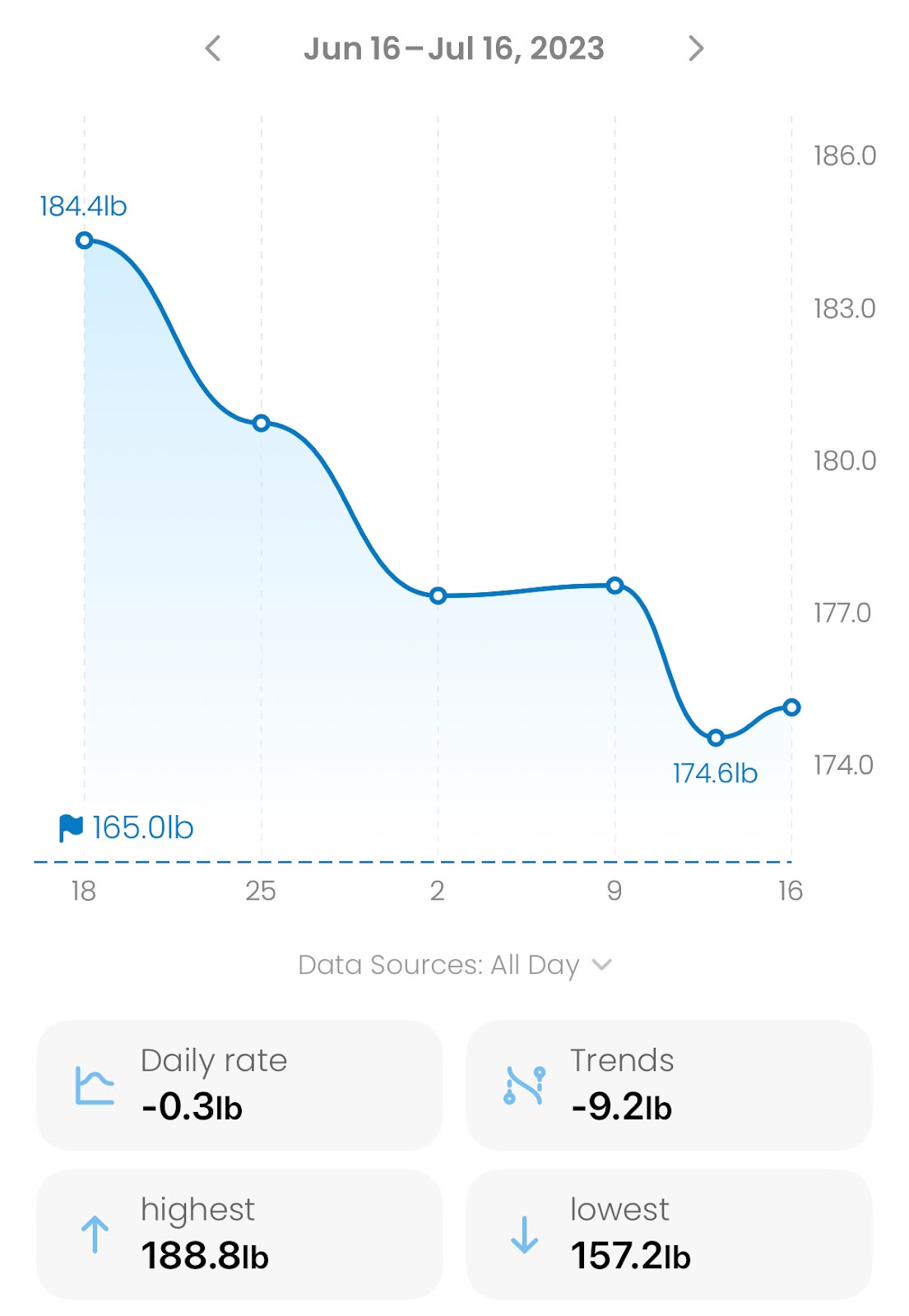How to lose 10 pounds of fat in 25 days
Using science and white knuckle discipline to get fast results
In the summer of 2023, I was invited by my coach, Ryan Matt Reynolds, CEO of Barbell Logic to his home in Springfield, Missouri, where I presented ‘‘The Importance and Power of Agency: For Both Coaches and Clients’’ at his annual staff conference. Beforehand, I was slacking off, missing lifts, and ballooning up in body fat all while tearing four pairs of dress pants in the process.
Matt knows how to deliver both compassion and accountability, but at this moment, he said I had to get it together and look the part if I planned to show up to represent the brand. In addition, I needed to get back under 175 pounds to stay in the lightweight division for powerlifting contests. At 176 pounds, I would have to compete against men much taller and hence, stronger.
Knowing that Reynolds was hosting a deadlifting contest in his garage upon my arrival, I had to figure out how to lose fat AND preserve muscle at the same time. While I do not advocate for the “white knuckle discipline” approach (because it is unsustainable), the goal of this post is to present exactly how I achieved such an extreme goal and to show readers the most simplified view of nutrition and fitness so they can reach their personal goals in 2025.
Americans are obsessed with “losing weight” and “being skinny,” but the number on the scale is just one metric of health. Body Mass Index (BMI) is probably the least helpful number as well. The reality is we are all in the “extreme sport of aging,” as cited in The Barbell Prescription: Strength Training for Life After 40.
Simply put, strength is your natural existence in the world, and once you lose it, you’re dead. Everyday is quite literally a fight against gravity and the barbell is the most simple and effective tool to keep you vertical for the long haul. Your body works as a system and should be trained as such. Unless you are going for aesthetics, workout machines are far less efficient = more time and less results. My biggest abs have come from 350-pound squats, not endless situps. Your driver should ask yourself first: “What is my WHY?”
For me, it’s a quality of life issue. Strength training makes everything else in life easier and I can attest that there are significant mental benefits from the refining process as well.
Understanding Nutrition
Calories: There are no bones about it. If you are going to lose fat, you have to run consistent calorie deficits. The problem is that if you want to gain muscle, you need to run a calorie surplus. As you age, the quality of calories matters too. With the three types of energy systems humans utilize, it is not possible to put on 100% muscle or lose 100% fat (even on performance enhancing drugs) BUT you can control the RATIO by eating clean and understanding macronutrients. I know first hand that the “dirty bulking” high school football players do with PB&J sandwiches is not a thing after age 35.
Macronutrients (Macros): Protein, Fat, Carbohydrates…and alcohol
Protein - 4 calories per gram. You need this to both recover and build muscle. My metric is 1g of protein per 1lb of body weight per day. If I lift heavy and miss my protein number by 25g or so, I am incredibly sore. It’s important to note that muscle soreness and (accumulated) fatigue are not the same thing. During my 825 mile 10-day cycling trip from Washington, D.C. to the Indiana Dunes in August, I was only sore one day after climbing 6,500 feet over 105 miles. When I returned to D.C. just a day after the ride, deadlifting came back fast (started at 315 pounds) as my lower back and hamstrings felt great but I had to drop my squat down over 120 pounds (to 185). Cycling is almost a purely quad workout and while they were never sore, the fatigue lasted for more than three weeks.
Fat - 9 calories per gram. Your body needs fat to operate but understand, it is in its final form. You are what you eat here. For fat loss, I ate less than 50 grams of fat per day and tried to get it naturally from the meat I was eating as well as from cooking sources like olive oil and butter so you can still enjoy the taste of things…like vegetables. Various nuts are my other play but you have to regulate yourself to a palmful which is one serving (1oz). Not easy! Note: fat is more than twice the calories of proteins and carbs so if you cut here you have a lot of room left over.
Carbohydrates - 4 calories per gram. This is the most contentious part of the nutrition world. Yes, if you are obese and looking to shed big pounds without exercising, zero carb diets like Keto get “instant results” because fat is satiating and hence, you eat less - but this is not the best long term strategy. Some believe that carbs = sugar = makes you more hungry. If you eat real food, which has fiber and lowers the glycemic index (GI), this won’t happen. I’ve never had hunger issues after a bowl of rice or oatmeal. If you are going to strength train, carbs are needed to fuel that movement. A person can store roughly 2-5g per pound of bodyweight as glycogen in your muscles – that’s a lot! Understand that carbs will make your muscles retain water so you might not feel skinnier but keep the mid and long term goals in mind and don’t obsess about the day to day scale or waist measurements. “Confusion marketing” is a thing in the industry and they prey on people’s insecurities. For women, I recommend the work of Barball Logic staff Niki Sims, an expert in the psychology of training in/around the monthly cycle or Nikki Burman when it comes to strength training during pregnancy and postpartum. These gals cut through all the non-sense sent to you by big business.
Alcohol - 7 calories per gram. This is the fourth macro you didn’t even know about. As a whiskey advocate, it pains me to write that alcohol is the devil when it comes to your fat loss goals. Booze operates like a half carb, half fat. It acts like sugar with no fiber so it messes with your blood sugar level, making you more hungry. Alcohol also operates like a fat because it has a high caloric load, but with little/no nutritional value, the equivalent of putting water in your gas tank. 100 calories of beer and 100 calories of green beans are not the same. If you are serious about cutting fat, abstinence is the only way here. Just think, ‘barrel strength’ whiskey is about 120 proof, which is essentially 120 calories per ounce – yikes!
Brett McKay, owner of the Art of Manliness, is also a client of Coach Reynolds. He has a podcast episode, Lose Weight and Keep It Off With Flexible Dieting where he explains his eating style “if it fits my macros.” I tend to follow this advice and “eyeball” my food with roughly 50% carb, 30% protein and 20% fat, however, this short term fat loss goal I completed required more extreme day to day swings. Weighing food is time consuming so unless you feel like you need the precision, just consider a fist full of anything to be considered one serving.
Strength vs. Cardio
Strength is slowly gained and slowly lost. Cardio is quickly gained and quickly lost. Either way, you need to be consistent with both. You can get leaner by just lifting but there are benefits to increasing your cardiovascular health. I see a lot of “skinny fat” retirees at the globo gyms because they are obsessed with weight and excessive high intensity cardio quite literally burns your muscle off. We already lose muscle as we age so there’s no reason to expedite the process. Strength training is a hedge for the unforeseen. If you get cancer, is it better to be strong and fluffy or skinny and weak? Which person will be able to endure chemo or radiation longer? There is a saying: “plan for the best but prepare for the worst. Be strong first, fast second.”
Know Your Biomarkers & Baselines
At 5’7”, my Resting Metabolic Rate (RMR) is a little under 1,800 calories. That is how much I burn sitting at a desk each day.
The Plan: My goal was to preserve muscle and lose 10 pounds of fat. A pound of fat is 3,500 calories. To lose 10 pounds of fat, that would be 35,000 in calorie deficits. To achieve this 25 days, that would be 1,400 per day – mathematically pretty impossible unless you starve yourself. Most coaches recommend no more than 500 calorie deficits per day so you’d lose basically one pound of fat per week. Depressingly slow.
Over the past few years, I noticed after long bike rides, my lifting the next day would go to crap. Going back to the three primary energy systems, the body can utilize carbs, fats or proteins to get you moving. A heart rate is the “fat burn zone” can be achieved by walking but that will be a time suck. High intensity interval training (HIIT) is by far the most efficient way to spend an hour.
In many ways, CrossFit falls into this category. Since I wanted to enjoy the process, I chose cycling and learned how to get the maximum fat burn benefit vs time without losing strength by maintaining a heart rate of 145 BPM. This would be the same as hiking and rucking, using stairs or a stair master at the gym. I oppose running because my base heart rate is 170+ and while it's a high calorie expenditure, it destroys your strength and quite frankly, just makes me hungry and tired. It’s also hard on the joints. As a former 5-minute miler, there are just so many better options out there. What I have learned over the years is whether I strength train or perform steady state cardio, I burn roughly 500 calories an hour so I factor that in on top of my RMR for calories burned per day.
Presenting at the Barbell Logic Annual Staff Conference
Plan of Action
Day 1:
Strength Train: Two routines: 1) squat and deadlift or 2) strict press, bench-press with a three-set mini-circuit of weighted (25lb) chinups, weighted dips and barbell curls to exhaustion. This causes hypertrophy, which is what makes your muscles physically larger. It’s also bonus cardio at the end of a workout. Sometimes I would bike around town for 30 minutes afterward.
Nutrition: focus on 175g (700 calories) of protein, 1g per lb of body weight to repair the muscles. The rest would be carbs and keep the fat under 50g.
Deficit target: at least 1,000 calories. RMR -1800 + Lifting -500 = -2300. With 700c of protein, I was still left with 600 calories left for both carbs and fat.
Day 2:
Cardio. I would cycle fasted (no breakfast) for two hours starting at 5 a.m., keeping my heart rate at that sweet spot of 145 BPM to maximize calories burned without losing muscle.
Nutrition: Low intensity cardio doesn’t tear muscle fibers much so you don’t need as much protein to recover. The goal here was to fast as long as possible then dump truck as many carbs in the evening to store them as glycogen in my muscles for the next morning’s lift.
Deficit Target: at least 500 calories. RMR -1800 + Cycling -1000 = -2800. A 500 deficit = 2300 I get to eat, which could be 575g of carbs!
Day 3 & 4 etc: Rise, Wash and Repeat Days 1 & 2 until white knuckle discipline blows up!
Results: I reached my goal the day before flying out. There were two times during that month where I showed up at the gym and could barely move – it felt something like pure exhaustion but working in Congress has its own element of fatigue that may have been a factor. Again, I don’t recommend wildly oscillating between heavy protein and heavy carb days. For the most part, I was able to hit all of the numbers Matt programmed for me, but I had no idea exactly how strong I was. After two flights, I landed at the event just as the deadlift competition was underway. I pulled 455 pounds which tied my all time best which was set a little over a year earlier in June 2022. I swear having people cheer you on adds 30 pounds to any lift too.
Competing in an online competition in June 2022
How I did it:
Food Tracking: I used the app Cronometer, recommended by popular YouTuber Thomas Frank, also a client of Coach Reynolds. It has a lot more nuanced foods than MyFitnessPal (MFP) and because users enter the food data on that app, there are many calorie counters out there that don’t input the macros. In many ways, MFP was not helpful to me. The free version of Cronometer allows you to see macro ratios as well as whether or not you want to factor your workout calories into the overall goal by linking with other apps – I love the barcode scanner too. I used my Apple Watch for lifting and Garmin computer for cycling. Since I have a wheat allergy, which led to an ethmoid surgery in 2022 and balloonplasty in 2023, my diet is clean by default since “enriched wheat” is in just about every junk food out there. It’s important to keep easy “open and consume” snacks on hand because you will get hungry. My default emergency lunch/dinner for the past 20 years has been Chipotle as it’s the “best price per calorie” in the industry ,and lifters have been doing the beans, rice, and chicken thing for a lot longer.
Strength Tracking: I’ve been a client of Barbell Logic since 2019. Coach Reynolds does ALL of my programming, I just show up and do the work. All the data is saved in an app they designed called TurnKeyCoach (TKC) which they license to any online coaches. You can find all of their services here.
Cardio Tracking: As a cyclist, there are two ways to track calories and performance: a heart rate monitor and a power meter. Most of D.C. is pretty flat so I just tried to keep my HR at 145 BPM so I got the biggest bang for my buck for the time spent. Not many people out at 5 a.m.!
Family: I have the luxury of being single with no children, which is a significant advantage when it comes to controlling the ability to show up to the gym as well as what goes in my mouth. I understand spousal food preferences, crazy kid schedules with after school sports and the like can make both training and eating well difficult. I’d strongly ask you to consider buying Coach Reynold’s new book, Undoing Urgency: Reclaim Your Time For The Things That Matter Most. It’s an easy read for anyone and will give you action items to follow. I just finished it and will be putting several items from it into practice for 2025.
Conclusion
Building muscle is hard. Losing fat is even harder. Author Nassim Taleb said in Antifragile: Things That Gain from Disorder, “Abundance is harder for us to handle than scarcity.” Instead of hunting or farming, unlimited calories can be brought to our door within minutes. We’ve removed every physical adversity needed to survive and with the creation of social media, some are trying to do the same on the mental side. The reality is humans evolved BECAUSE of scarcity and hardship, both mental and physical. A lot of it was involuntary, not of our choosing, but it was impossible to escape. It has been said “no pain, no gain” and the reality is we need to pursue voluntary hardship, aka getting under a heavy barbell because that is how we will be refined and better prepared for when the involuntary hardships in life come.
If you are looking to make a nutrition change in the new year, I recommend starting with Barbell Logic’s 10 Day Challenge. Most regimens are all about taking things away but the developer of this program, Gillian Ward, has a keen understanding of our relationships with food so 9 out of the 10 days includes adding something to your habits.
Now that you know the plan, it's time to put it into action. I'm going to try this regimen again and will report back at the end of January with a progress report. Happy New Year!





